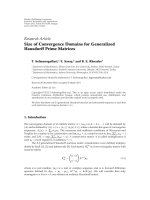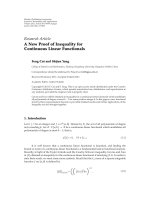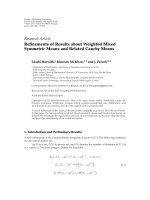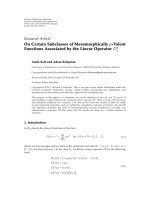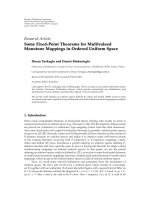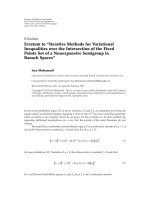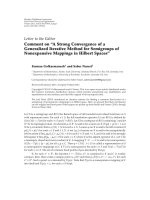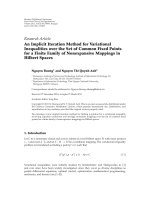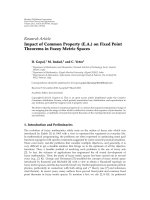Hindawi Publishing Corporation Journal of Inequalities and Applications Volume 2011, Article ID ppt
Bạn đang xem bản rút gọn của tài liệu. Xem và tải ngay bản đầy đủ của tài liệu tại đây (509.68 KB, 14 trang )
Hindawi Publishing Corporation
Journal of Inequalities and Applications
Volume 2011, Article ID 131240, 14 pages
doi:10.1155/2011/131240
Research Article
Size of Convergence Domains for Generalized
Hausdorff Prime Matrices
T. Selmanogullari,
1
E. Savas¸,
2
and B. E. Rhoades
3
1
Department of Mathematics, Mimar Sinan Fine Arts University, Besiktas, 34349 Istanbul, Turkey
2
Department of Mathematics, Istanbul Commerce University, Uskudar, 34672 Istanbul, Turkey
3
Department of Mathematics, Indiana University, Bloomington, IN 47405-7106, USA
Correspondence should be addressed to T. Selmanogullari,
Received 8 December 2010; Accepted 2 March 2011
Academic Editor: Q. Lan
Copyright q 2011 T. Selmanogullari et al. This is an open access article distributed under the
Creative Commons Attribution License, which permits unrestricted use, distribution, and
reproduction in any medium, provided the original work is properly cited.
We show that there exit E-J generalized Hausdorff matrices and unbounded sequences x such that
each matrix has convergence domain c ⊕ x.
1. Introduction
The convergence domain of an infinite matrix A a
nk
n, k 0, 1, will be denoted by
A and is defined by A : {x {x
n
}|A
n
x ∈ c}, where c denotes the space of convergence
sequences, A
n
x :
k
a
nk
x
k
. The necessary and sufficient conditions of Silverman and
Toeplitz for a matrix to be conservative are lim
n
a
nk
a
k
exists for each k, lim
n
∞
k0
a
nk
t
exists, and ||A|| : sup
n
∞
k0
|a
nk
| < ∞. A conservative matrix A is called multiplicative if
each a
k
0 and regular if, in addition, t 1.
The E-J generalized Hausdorff matrices under consideration were defined indepen-
dently by Endl 1, 2 and Jakimovski 3. Each matrix H
α
μ
is a lower triangular matrix with
nonzero entries
h
α
nk
⎛
⎝
n α
n − k
⎞
⎠
Δ
n−k
μ
k
, 1.1
where α is real number, {μ
n
} is a real or complex sequence and Δ is forward difference
operator defined by Δμ
k
μ
k
− μ
k1
, Δ
n1
μ
k
ΔΔ
n
μ
k
. We will consider here only
nonnegative α. For α 0, one obtains an ordinary Hausdorff matrix.
2 Journal of Inequalities and Applications
From 1 or 3 a E-J generalized Hausdorff matrix for α>0 is regular if and only if
there exists a function χ ∈ BV 0, 1 with χ1 − χ0 1 such that
μ
α
n
1
0
t
nα
dχ
t
, 1.2
in which case χ is called the moment generating function, or mass function, for H
α
μ
and μ
α
n
is called moment sequence.
For ordinary Hausdorff summability 4, the necessary and sufficient conditions, for
regularity are that function χ ∈ BV 0, 1, χ1 − χ01, χ0 χ0,and1.2 is satisfied
with α 0.
As noted in 5, the set of all multiplicative Hausdorff matrices forms a commutative
Banach algebra that is also an integral domain, making it possible to define the concepts of
unit, prime, divisibility, associate, multiple, and factor. Hille and Tamarkin 6, 7,using
some techniques from 8, showed that every Hausdorff matrix with moment function
μ
z
z − a
z b
,R
a
> 0,R
b
> 0 1.3
is prime. In 1967, Rhoades 9 showed that the convergence domain of every known prime
Hausdorff matrix is of the form c ⊕ x for a particular unbounded sequence x.
Given any unbounded sequence x, Zeller 10 constructed a regular matrix A with
convergence domain Ac ⊕ x. It has been shown by Parameswaran 11 that if x is any
unbounded sequence such that {x
n
− x
n−1
} is bounded, divergent, and Borel summable, then
no Hausdorff matrix H exists with Hc ⊕ x.
The main result of this paper is to show that there exist E-J generalized Hausdorff
matrices H
α
μ
whose moment sequences are
μ
α
n
n − a
n b α
,R
a
> 0,R
b
> 0, 1.4
and unbounded sequences x
α
such that each matrix has convergent domain c ⊕ x
α
.
Define the sequences x
α
by
x
α
n
Γ
n α 1
Γ
n − a 1
for R
a
> 0, 1.5
where it is understood that if a is positive integer, then x
α
n
0forn 0, 1, ,a− 1.
If λ
α
n
is the moment sequence defined by n − a/n 1 α, Ra > 0, then it is clear
that H
α
μ
H
α
λ
. Hence, it will be sufficient to prove the theorem by using b 1, in 1.4.
To have the convenience of regularity, we will use the sequence
μ
α
n
n − a
−
a α
n 1 α
, 1.6
since the constant −1/a α does not affect the size of the convergence domain of H
α
μ
.
Journal of Inequalities and Applications 3
2. Auxiliary Results
In order to prove the main theorem of this paper, we will need the following results.
Lemma 2.1. Let A, B ∈ C, d, n ∈ N ∪{0}, d ≤ n. Then, formally, for any n,
n
kd
Γ
A k
Γ
B k
1
A − B 1
Γ
A n 1
Γ
B n
−
Γ
A d
Γ
B − 1 d
. 2.1
Proof. Lemma 2.1 appears as formula 12 on page 138 of 12.
Lemma 2.2. For m, n integers n>m 1 >a, x
α
n
as in 1.5,
n
km1
1
x
α
k
k − a
1
a α
1
x
α
m
−
1
x
α
n
. 2.2
Proof. Using Lemma 2.1,
n
km1
1
x
α
k
k − a
n
km1
Γ
k − a
Γ
k α 1
1
−a −
α 1
1
Γ
n 1 − a
Γ
n 1 α
−
Γ
m 1 − a
Γ
m 1 α
1
a α
1
x
α
m
−
1
x
α
n
.
2.3
Lemma 2.3. For 0 ≤ r ≤ a
−
n−1
ja1
h
α
nj
−1
h
α
jr
x
α
n
Γ
a α 1
−
a α 1
n − a
. 2.4
Proof. μ
α
n
can be written as
μ
α
n
−1
a α
a α 1
a α
n α 1
, 2.5
4 Journal of Inequalities and Applications
so that, for 0 ≤ k<n, h
α
nk
a α 1/a αn 1 α.FromLemma 2.1 and 3.11,
−
n−1
ja1
h
α
nj
−1
h
α
jr
−
n−1
ja1
−x
α
n
a α
a α 1
2
x
α
j
j − a
a α
j α 1
a α 1
2
x
α
n
n−1
ja1
Γ
j − a
Γ
j 2 α
a α 1
2
x
α
n
a α 1
1
Γ
a α 2
−
Γ
n − a
Γ
n 1 α
x
α
n
Γ
a α 1
−
a α 1
n − a
.
2.6
3. Main Result
Theorem 3.1. If for fixed a and b the matrix H
α
μ
is defined by 1.4 and a sequence x
α
by 1.5,
then H
α
μ
c ⊕ x
α
.
Proof. We will first show that c ⊕ x
α
⊆ H
α
μ
.
We can write the matrix H
α
μ
−1/a αI − H
α
λ
, where the diagonal entries of
H
α
λ
are
λ
α
n
a α 1
n α 1
. 3.1
For each n and k,
Δ
n−k
λ
α
k
a α 1
1
0
t
kα
1 − t
n−k
dt
a α 1
Γ
k α 1
Γ
n − k 1
Γ
n α 2
.
3.2
Therefore,
H
α
λ
n,k
n α
n − k
Δ
n−k
λ
α
k
n α
n − k
a α 1
Γ
k α 1
Γ
n − k 1
Γ
n α 2
a α 1
n α 1
.
3.3
Journal of Inequalities and Applications 5
Define y
n
−u
n
/a α, where
u
n
x
α
n
−
n
k0
h
α
n,k
x
α
k
. 3.4
From Lemma 2.1,
u
n
Γ
n α 1
Γ
n − a 1
−
a α 1
n α 1
α a 1
Γ
n α 2
Γ
n − a 1
−
Γ
α 1
Γ
−a
Γ
n α 1
Γ
n − a 1
1 − 1
Γ
α 1
Γ
−a
n α 1
Γ
α 1
Γ
−a
n α 1
−→ 0asn −→ ∞ .
3.5
This argument is valid provided a is not a positive integer. If a is a positive integer, then
x
α
k
0for0≤ k ≤ a − 1.
Then, u
n
0for0≤ n ≤ a − 1, and for n ≥ a,fromLemma 2.1,weget
u
n
x
α
n
−
a α 1
n α 1
n
ka
Γ
k α 1
Γ
k − a 1
Γ
n α 1
Γ
n − a 1
−
a α 1
n α 1
Γ
a α 1
Γ
1
−
1
n α 1
Γ
n α 2
Γ
n − a 1
−
Γ
a α 2
Γ
1
Γ
n α 1
Γ
n − a 1
−
Γ
a α 2
n 1 α
−
Γ
n α 2
n 1 α
Γ
n − a 1
Γ
a α 2
n 1 α
Γ
n α 1
Γ
n − a 1
1 −
n 1 α
n 1 α
0 −→ 0asn −→ ∞ .
3.6
Since H
α
μ
is regular, c ⊆ H
α
μ
.Thus,c ⊕ x
α
⊆ H
α
μ
.
To prove the converse, we will use Zeller’s technique to construct a regular matrix A
with Ac ⊕ x
α
and then show that H
α
μ
⊆ A.
Set P
0
0 and define a sequence {P
n
} inductively by selecting P
n1
to be smallest
integer P>P
n
such that |x
α
P
|≥2 |x
α
P
n
|. Such a construction is clearly possible, since x
α
is
not bounded. Let q
α
n
1 − x
α
P
n−1
/x
α
P
n
, n 1, 2, Define a matrix B by
b
00
1,
b
n,n−1
1
q
α
n
,n≥ 1,
b
n,n
−
x
α
P
n−1
q
α
n
x
α
P
n
,n≥ 1,
b
n,k
0 otherwise.
3.7
6 Journal of Inequalities and Applications
Now, define the matrix A as follows:
a
P
n
,P
k
b
nk
,
a
P
n
,k
0,k
/
P
i
for any integer i,
a
nn
1,n
/
P
i
for any integer i.
3.8
If n
/
P
i
for any integer i, then there exists an integer r such that P
r
<n<P
r1
. For this r,
define
a
n,P
r−1
x
α
n
x
α
P
r
− x
α
P
r−1
,
a
n,P
r
−x
α
n
x
α
P
r
− x
α
P
r−1
.
3.9
Set a
nk
0 otherwise. From 10, A is regular and Ac ⊕ x
α
. There are three cases to
consider, based on whether a is real number and not a positive integer, a is positive integer,
or a is complex.
Proof of Case I. If a is real and not a positive integer, the E-J generalized Hausdorff matrix
H
α
μ
generated by 1.6 has a unique two sided inverse H
α
μ
−1
h
α
nk
−1
with generating
sequence
1
μ
α
n
−
a α
n 1 α
n − a
−
a α
−
a α
a α 1
n − a
. 3.10
For k<n,
h
α
nk
−1
n α
n − k
Δ
n−k
1
μ
α
k
−
a α
a α 1
Γ
n α 1
Γ
k − a
Γ
k α 1
Γ
n − a 1
−x
α
n
a α
a α 1
x
α
k
k − a
,
3.11
h
α
nn
−1
−
a α
n 1 α
n − a
. 3.12
To show that H
α
μ
⊆ A, it will be sufficent to show that D AH
α
μ
−1
is a regular matrix.
Each column of H
α
μ
−1
is essentially a scalar multiple of 1.5, so it is obvious that each
Journal of Inequalities and Applications 7
column of H
α
μ
−1
belongs to the convergence domain of A. However, it will be necessary to
calculate the terms of D explicitly, since we must show that t 1andthatD has finite norm.
If k
/
P
i
for any integer i,andr denotes the integer such that P
r−1
<k<P
r
, then from
the definition of A,
d
P
n
,k
n
jr
a
P
n
,P
j
h
α
P
j
,k
−1
b
n,n−1
h
α
P
n−1
,k
−1
b
nn
h
α
P
n
,k
−1
0.
3.13
If k P
r
for r<n− 1, then
d
P
n
,P
r
n
jr
a
P
n
,P
j
h
α
P
j
,P
r
−1
0.
3.14
For k P
n−1
,
d
P
n
,P
n−1
a
P
n
,P
n−1
h
α
P
n−1
,P
n−1
−1
a
P
n
,P
n
h
α
P
n
,P
n−1
−1
1
q
α
n
−
a α
P
n−1
α 1
P
n−1
− a
⎛
⎝
−x
α
P
n−1
q
α
n
x
α
P
n
⎞
⎠
⎛
⎝
−
a α
a α 1
x
α
P
n
x
α
P
n−1
P
n−1
− a
⎞
⎠
−
a α
q
α
n
.
3.15
For P
n−1
<k<P
n
,
d
P
n
,k
a
P
n
,P
n
h
α
P
n
,k
−1
a α
1 a α
x
α
P
n−1
k − a
q
α
n
x
α
k
,
3.16
d
P
n
,P
n
a
P
n
,P
n
h
α
P
n
,P
n
−1
a α
1 α P
n
x
α
P
n−1
P
n
− a
q
α
n
x
α
P
n
.
3.17
For n
/
P
i
for any i,ifwenowletr denote the integer such that P
r
<n<P
r1
, then for
0 <k<P
r−1,
d
nk
n
jk
a
n,j
h
α
j,k
−1
a
n,P
r−1
h
α
P
r−1
,k
−1
a
n,P
r
h
α
P
r
,k
−1
a
n,n
h
α
n,k
−1
0.
3.18
8 Journal of Inequalities and Applications
For k P
r−1
,
d
n,P
r−1
a
n,P
r−1
h
α
P
r−1
,P
r−1
−1
a
n,P
r
h
α
P
r
,P
r−1
−1
a
n,n
h
α
n,P
r−1
−1
−
a α
x
α
n
P
r−1
− a
⎛
⎝
P
r−1
α 1
x
α
P
r
− x
α
P
r−1
−
a α 1
x
α
P
r
− x
α
P
r−1
x
α
P
r
x
α
P
r−1
a α 1
x
α
P
r−1
⎞
⎠
−
a α
x
α
n
P
r−1
− a
⎛
⎝
P
r−1
α 1
x
α
P
r
− x
α
P
r−1
−
a α 1
x
α
P
r
− x
α
P
r−1
⎞
⎠
−
a α
x
α
n
x
α
P
r
− x
α
P
r−1
.
3.19
For P
r−1
<k<P
r
,
d
nk
a
n,P
r
h
α
P
r
,k
−1
a
n,n
h
α
n,k
−1
a α
a α 1
x
α
n
x
α
P
r−1
x
α
k
x
α
P
r
− x
α
P
r−1
k − a
.
3.20
For k P
r
,
d
n,P
r
a
n,P
r
h
α
P
r
,P
r
−1
a
n,n
h
α
n,P
r
−1
−
a α
x
α
n
P
r
− a
⎡
⎣
−
P
r
α 1
x
α
P
r
− x
α
P
r−1
a α 1
x
α
P
r
⎤
⎦
−
a α
x
α
n
P
r
− a
x
α
P
r
x
α
P
r
− x
α
P
r−1
−
P
r
α 1
x
α
P
r
x
α
P
r
− x
α
P
r−1
a α 1
.
3.21
The quantity in brackets is equal to −P
r
− ax
α
P
r
− x
α
P
r−1
a α 1, giving
d
n,P
r
a α
x
α
n
x
α
P
r
−
x
α
P
r−1
x
α
n
x
α
P
r
a α
a α 1
x
α
P
r−1
P
r
− a
x
α
P
r
− x
α
P
r−1
. 3.22
For P
r
<k<n,
d
n,k
a
n,n
h
α
n,k
−1
−x
α
n
x
α
k
a α
a α 1
k − a
, 3.23
Journal of Inequalities and Applications 9
and finally,
d
n,n
−
a α
n 1 α
n − a
. 3.24
By using 3.13–3.17,
P
n
k0
d
P
n
,k
d
P
n
,P
n−1
P
n
−1
kP
n−1
1
d
P
n
,k
d
P
n
,P
n
a α
q
α
n
⎡
⎣
−1 x
α
P
n−1
a α 1
P
n
−1
kP
n−1
1
1
x
α
k
k − a
P
n
α 1
x
α
P
n−1
P
n
− a
x
α
P
n
⎤
⎦
.
3.25
By using Lemma 2.2, and noting that
P
n
α 1
P
n
− a
1
1 a α
P
n
− a
,
P
n
k0
d
P
n
,k
a α
q
α
n
⎡
⎣
−1 x
α
P
n−1
a α 1
a α
⎛
⎝
1
x
α
P
n−1
−
1
x
α
P
n
−1
⎞
⎠
1 a α
P
n
− a
x
α
P
n−1
x
α
P
n
x
α
P
n−1
x
α
P
n
⎤
⎦
a α
q
α
n
⎡
⎣
−1
a α 1
a α
−
a α 1
a α
x
α
P
n−1
x
α
P
n
−1
1 a α
P
n
− a
x
α
P
n−1
x
α
P
n
x
α
P
n−1
x
α
P
n
⎤
⎦
.
3.26
Note that
−
a α 1
a α
x
α
P
n−1
x
α
P
n
−1
1 a α
P
n
− a
x
α
P
n−1
x
α
P
n
a α 1
⎡
⎣
−
x
α
P
n−1
a α
x
α
P
n
−1
x
α
P
n−1
P
n
− a
x
α
P
n
⎤
⎦
a α 1
⎡
⎣
−
x
α
P
n−1
Γ
P
n
− a
a α
Γ
P
n
α
x
α
P
n−1
Γ
P
n
− a 1
P
n
− a
Γ
P
n
α 1
⎤
⎦
a α 1
Γ
P
n
− a
Γ
P
n
α
⎡
⎣
−x
α
P
n−1
a α
x
α
P
n−1
P
n
α
⎤
⎦
−
a α 1
Γ
P
n
− a 1
x
α
P
n−1
Γ
P
n
α 1
a α
.
3.27
10 Journal of Inequalities and Applications
Finally,
P
n
k0
d
P
n
,k
a α
q
α
n
⎡
⎣
−1
a α 1
a α
x
α
P
n−1
x
α
P
n
−
a α 1
Γ
P
n
− a 1
x
α
P
n−1
a α
Γ
P
n
α 1
⎤
⎦
a α
q
α
n
⎡
⎣
−1
a α 1
a α
⎛
⎝
1 −
x
α
P
n−1
x
α
P
n
⎞
⎠
x
α
P
n−1
x
α
P
n
⎤
⎦
a α
q
α
n
⎡
⎣
−1
1 a α
q
α
n
a α
x
α
P
n−1
x
α
P
n
⎤
⎦
−
a α
q
α
n
⎛
⎝
1 −
x
α
P
n−1
x
α
P
n
⎞
⎠
1 a α
1.
3.28
For n
/
P
i
for any i, r the integer such that P
r
<n<P
r1
,andusing3.18–3.24, we have
n
k0
d
nk
a α
x
α
n
x
α
P
r
− x
α
P
r−1
⎡
⎣
−1 x
α
P
r−1
a α 1
P
r
−1
kP
r−1
1
1
x
α
k
k − a
1
x
α
P
r−1
a α 1
x
α
P
r
P
r
− a
⎤
⎦
n−1
kP
r
1
−x
α
n
a α
a α 1
x
α
k
k − a
−
a α
n 1 α
n − a
.
3.29
Writing n 1 α/n − a1x
α
n
1 a α/x
α
n
n− a and using Lemma 2.2, the quantity
in brackets, which we call I
1
, takes the form
I
1
x
α
P
r−1
a α 1
a α
⎛
⎝
1
x
α
P
r−1
−
1
x
α
P
r
−1
⎞
⎠
x
α
P
r−1
a α 1
x
α
P
r
P
r
− a
x
α
P
r−1
a α 1
⎛
⎝
1
a α
x
α
P
r−1
−
1
a α
x
α
P
r
−1
1
x
α
P
r
P
r
− a
⎞
⎠
.
3.30
The sum
−
1
a α
x
α
P
r
−1
1
x
α
P
r
P
r
− a
−
Γ
P
r
− a
a α
Γ
P
r
α
Γ
P
r
− a 1
P
r
− a
Γ
P
r
α 1
−
1
a α
x
α
P
r
.
3.31
Journal of Inequalities and Applications 11
Thus,
a α
x
α
n
x
α
P
r
− x
α
P
r−1
I
1
a α
x
α
n
x
α
P
r
− x
α
P
r−1
x
α
P
r−1
a α 1
⎛
⎝
1
a α
x
α
P
r−1
−
1
a α
x
α
P
r
⎞
⎠
x
α
n
a α 1
x
α
P
r
.
3.32
Finally,
n
k0
d
nk
x
α
n
a α 1
x
α
P
r
−
a α
1 a α
x
α
n
⎡
⎣
n−1
kP
r
1
1
x
α
k
k − a
1
x
α
n
n − a
⎤
⎦
−
a α
a α 1
x
α
n
x
α
P
r
−
a α
1 a α
x
α
n
⎡
⎣
1
a α
⎛
⎝
1
x
α
P
r
−
1
x
α
n
⎞
⎠
⎤
⎦
−
a α
a α 1
x
α
P
r
x
α
n
−
x
α
n
− x
α
P
r
−
a α
1.
3.33
Clearly, D has null columns. It remains to show that D has finite norm.
For all integers, n ≥ a1, x
α
n
is positive and 1/2 ≤ q
α
n
≤ 1. From 3.25,
P
n
k0
d
P
n,
k
d
P
n,
P
n−1
P
n
−1
kP
n−1
1
d
P
n,
k
d
P
n,
P
n
a α
q
α
n
⎡
⎣
1
x
α
P
n−1
x
α
P
n
⎤
⎦
1 a α.
3.34
Since |x
α
P
n
|≥2|x
α
P
n−1
|, then, x
α
P
n−1
/x
α
P
n
≤ 1/2, and the above sum is bounded by 4α 4a 1.
From 3.29,
n
k0
|
d
nk
|
2
a α
x
α
n
x
α
P
r
− x
α
P
r−1
a α
2
a α 1
x
α
n
x
α
P
r
−
a α 1
. 3.35
From choice of n, |x
α
n
| < 2|x
α
P
r
|. Again, using the fact that |x
α
P
r
|≥2|x
α
P
r−1
|, we have
n
k0
|
d
nk
|
<
2
a α
2
x
α
P
r
x
α
P
r
−
x
α
P
r
/2
4
a α 1
2
a α
1 14
a α
5. 3.36
12 Journal of Inequalities and Applications
Since there are only a finite number of rows of D with n<a1, D has finite norm and is
regular.
Proof of Case II. If a is a positive integer, μ
α
a
0, and H
α
μ
fails to have a two-sided inverse.
However, if we define a new matrix F f
nk
with f
a,a
1 and which agrees with H
α
μ
elsewhere, then F does possess a unique two-sided inverse. Morever, FH
α
μ
and, for
k>a, f
−1
nk
h
α
nk
−1
, where the h
α
nk
−1
are computed using 3.11 and 3.12.
From 1.5, x
α
n
0for0≤ n<a. Consequently, P
0
0,P
1
a and P
2
a 1. Now, let
E : AF
−1
e
nk
. To prove that E is regular, we are concerned with the behavior of the e
nk
for all n sufficiently large. We will restrict our attention to n>a 1. Since f
−1
nk
h
α
nk
−1
for
all k>a, it is clear that e
nk
d
nk
for k>a. If we can show that e
nk
0 for all 0 ≤ k ≤ a and
n>a 1, then it will follow that E is regular, since D is.
For n>a 1,
n
ja
f
−1
nj
f
ja
0,
f
−1
na
f
aa
−
n
ja1
f
−1
nj
f
ja
−
n−1
ja1
h
α
nj
−1
h
α
ja
−
h
α
nn
−1
h
α
na
.
3.37
Since f
a,a
1andh
α
nn
−1
h
α
na
−aα1/n−a,f
−1
na
x
α
n
/Γaα1. By induction
it is showed that f
−1
n,a−r
k
α
r
ax
α
n
, where k
α
r
a is a function of a.
For n>a 1,P
n−1
>P
a
≥ P
1
a ≥ r
e
P
n
,r
P
n
jr
a
P
n
,j
f
−1
jr
b
n,n−1
f
−1
P
n−1
,r
b
n,n
f
−1
P
n
,r
1
q
α
n
⎛
⎝
k
α
a−r
a
x
α
P
n−1
−
x
α
P
n−1
x
α
P
n
x
α
P
n
k
α
a−r
a
⎞
⎠
0.
3.38
For n>a 1, n
/
P
i
for any integer i,0≤ r ≤ a,ands the integer such that P
s
<n<P
s1
,
e
n,r
n
jr
a
n,j
f
−1
jr
a
n,P
s−1
f
−1
P
s−1
,r
a
n,P
s
f
−1
P
s
,r
a
n,n
f
−1
n,r
x
α
n
x
α
P
s
− x
α
P
s−1
k
α
a−r
a
x
α
P
s−1
− k
α
a−r
a
x
α
P
s
k
α
a−r
a
x
α
n
0.
3.39
Proof of Case III. If a is complex, then none of the μ
α
n
vanish, and we may use the matrix D
of Case I. It will be sufficient to show that D has finite norm. From 3.25,
P
n
k0
|
d
P
n
,k
|
−
a α
q
α
n
a α
P
n
α 1
x
α
P
n−1
q
α
n
P
n
− a
x
α
P
n
P
n
−1
kP
n−1
2
|
d
P
n
,k
|
|
d
P
n
,P
n−1
1
|
. 3.40
Journal of Inequalities and Applications 13
Again, |x
α
P
n
|≥2|x
α
P
n−1
|. It can be shown that 1/2 ≤|q
α
n
|≤3/2. Since
|
d
P
n
,P
n−1
1
|
a α
a α 1
q
α
n
P
n−1
1 α
, 3.41
the first two and last terms of 3.40, are clearly bounded in n.
For P
n−1
1 <k<P
n
,using3.16,
|
d
P
n
,k
|
a α
a α 1
Γ
P
n−1
1 α
Γ
k − a
Γ
P
n−1
1 − a
Γ
k 1 α
q
α
n
a α
a α 1
k − a − 1
···
P
n−1
− a 1
Γ
k 1 α
q
α
n
Γ
P
n−1
1 α
≤
a α
a α 1
Γ
P
n−1
1 α
q
α
n
·
|
P
n−1
1 − a
|
|
P
n−1
1 − a
|
1
···
|
P
n−1
1 − a
|
k − P
n−1
− 2
Γ
k 1 α
a α
a α 1
Γ
P
n−1
1 α
q
α
n
Γ
|
P
n−1
1 − a
|
Γ
k w
Γ
k 1 α
,
3.42
where w |P
n−1
1 − a|−P
n−1
− 1. w<0 for all n sufficiently large. From Lemma 2.1, we can
write
P
n
−1
kP
n−1
2
|
d
P
n
,k
|
≤
a α
a α 1
Γ
P
n−1
1 α
q
α
n
Γ
|
P
n−1
1 − a
|
Γ
x w
w − α
Γ
x α
P
n
P
n−1
2
<
a α
a α 1
Γ
P
n−1
1 α
q
α
n
Γ
|
P
n−1
1 − a
|
Γ
P
n−1
2 w
α − w
Γ
P
n−1
2 α
,
3.43
and the sum is uniformly bounded in n,since−w is bounded away from zero.
If n
/
P
i
, for any i, then from 3.29,
n
k0
|
d
nk
|
−
a α
x
α
n
x
α
P
r
− x
α
P
r−1
P
r
−1
kP
r−1
1
a α
a α 1
x
α
P
r−1
x
α
n
x
α
P
r
− x
α
P
r−1
x
α
k
k − a
a α
x
α
n
x
α
P
r
− x
α
P
r−1
a α
a α 1
x
α
P
r−1
x
α
n
x
α
P
r
− x
α
P
r−1
x
α
P
r
P
r
− a
n−1
kP
r
1
a α
a α 1
x
α
n
x
α
k
k − a
−
a α
n 1 α
n − a
.
3.44
14 Journal of Inequalities and Applications
Terms 1, 3, 4, and 6 of 3.44 are clearly bounded in n. Recalling that q
α
r
1 − x
α
P
r−1
/x
α
P
r
,the
first summation may be written in the form
a α
a α 1
x
α
n
q
α
r
x
α
P
r
P
r
−1
kP
r−1
1
x
α
P
r−1
x
α
k
k − a
. 3.45
The summation is identical with the one in 3.40, and the above expression is uniformly
bounded, since |x
α
n
| < 2|x
α
P
r
|. Using an argument similar to the one used in establishing
3.40, the second summation of 3.44 can be shown to be uniformly bounded.
Acknowledgment
The first author acknowledges support from the Scientific and Technical Research Council of
Turkey in the preparation of this paper, the authors wish to thank the referee for his careful
reading of the manuscript and for his helpful suggestions.
References
1 K. Endl, “Abstracts of short communications and scientific program,” International Congress of
Mathematicians, vol. 73, p. 46, 1958.
2 K. Endl, “Untersuchungen
¨
uber Momentenprobleme bei Verfahren vom Hausdorffschen Typus,”
Mathematische Annalen, vol. 139, pp. 403–432, 1960.
3 A. Jakimovski, “The product of summability methods; new classes of transformations and their
properties,” Tech. Note, Contract no. AF61 052-187, 1959.
4 G. H. Hardy, Divergent Series, Clarendon Press, Oxford, UK, 1949.
5 E. Hille and R. S. Phillips, Functional Analysis and Semi-Groups, vol. 31 of American Mathematical Society
Colloquium Publications, American Mathematical Society, Providence, RI, USA, 1957.
6 E. Hille and J. D. Tamarkin, “On moment functions,” Proceedings of the National Academy of Sciences of
the United States of America, vol. 19, pp. 902–908, 1933.
7 E. Hille and J. D. Tamarkin, “Questions of relative inclusion in the domain of Hausdorff means,”
Proceedings of the National Academy of Sciences of the United States of America, vol. 19, pp. 573–577, 1933.
8 L. L. Silvermann and J. D. Tamarkin, “On the generalization of Abel’s theorem for certain definitions
of summability,” Mathematische Zeitschrift, vol. 29, pp. 161–170, 1928.
9 B. E. Rhoades, “Size of convergence domains for known Hausdorff prime matrices,” Journal of
Mathematical Analysis and Applications, vol. 19, pp. 457–468, 1967.
10 K. Zeller, “Merkw
¨
urdigkeiten bei Matrixverfahren; Einfolgenverfahren,” Archiv f
¨
ur Mathematische,
vol. 4, pp. 1–5, 1953.
11 M. R. Parameswaran, “Remark on the structure of the summability field of a Hausdorff matrix,”
Proceedings of the National Institute of Sciences of India. Part A, vol. 27, pp. 175–177, 1961.
12 H. T. Davis, The Summation of Series, The Principia Press of Trinity University, San Antonio, Texas,
USA, 1962.
